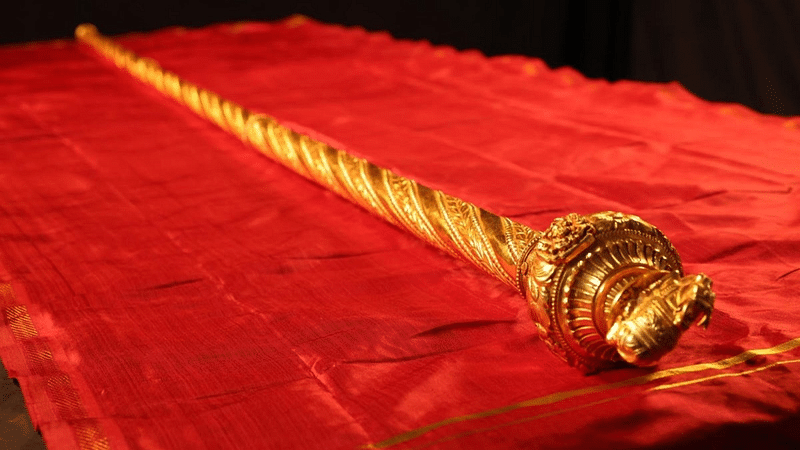For all the hype generated over the Sengol, the govt must follow the tradition to the T. Goddesses to Jayalalithaa, a woman figurehead must preside over it.
Praveen Chakravarty
May 26, 2023

A golden ‘sengol’ will be installed by Prime Minister Narendra Modi in the new Parliament building in New Delhi | ANI Photo
At about 11:54 am on 24 May, there was a sudden burst of activity on Google Search in India. People were searching for information using the keyword ‘sengol’. There had been no searches for this word in the past few months or a year, as per Google data. The reason for this sudden interest was that Union Home Minister Amit Shah announced at that time that a golden sceptre called Sengol will be installed in India’s new Parliament building.
Online media publications erupted almost instantaneously with explainers for Sengol and the history behind it. We were informed that Chakravarty Rajagopalachari (Rajaji), Independent India’s first Governor-General, gave the idea of a Sengol being handed over to Jawaharlal Nehru by Albert Mountbatten to signify the transition of power. Rajaji, the devout Tamil Brahmin, requested the head (seer) of the Shaivite mutt, Thiruvaduthurai Adheenam in Thanjavur district in Tamil Nadu, to arrange for a Chola-period-style Sengol for the historic occasion of the transfer of power from the British to Indians.
A special Sengol was carved in gold by a jeweller in Madras (now Chennai). An elaborate and overtly religious ceremony was held, replete with the sprinkling of Ganga Jal and chanting of hymns composed by 7th-century saint Thirugnanasambanthar, and the Sengol was handed over by Mountbatten to Nehru on the midnight of 14 August 1947.
On 24 May, while the rest of India was frantically searching for the term Sengol on Google, people in Tamil Nadu were not. Google data shows that nearly five times more Delhiites searched for Sengol than Tamilians on the same day. Tamilians were nonchalant because Sengol is neither new to Tamil culture nor a novelty in Tamil politics
Why Tamilians aren’t excited
It is generally believed that the tradition of handing over Sengol to a new king is a Chola dynasty custom, though scholars of the Sangam era date it even earlier. The most iconic historiography of a Sengol is an 18th-century painting in the famous Meenakshi Amman Temple in Madurai in which the goddess is handing over the sceptre to the Nayaka kings. There is another painting in the Ramalinga Vilasam palace of the 18th-century Sethupathi kings in the Ramanathapuram district where Goddess Rajarajeshwari is seen giving a Sengol to a Sethupathi king.
In contemporary Tamil politics, the most famous incident involving a Sengol happened in Madurai in July 1986. A massive conference was organised by then-ruling All India Anna Dravida Munnetra Kazhagam (AIADMK) during which propaganda secretary J Jayalalithaa brought a Sengol for her political mentor and Chief Minister MG Ramachandran (MGR). The event produced a picture in which MGR and Jayalalithaa are both seen holding the Sengol.
It was then used craftily by Jayalalithaa’s supporters later during a power struggle within the party to claim that MGR’s handover of the Sengol to Jayalalithaa signalled that she was his anointed heir. This picture is still much talked about in Tamil politics. Clearly, there was no apparent need for Tamilians to get excited over Shah’s announcement of a Sengol being installed in India’s new Parliament.
Now follow the tradition too
The Narendra Modi government, though, must be lauded for the thoughtful and creative idea to bring India’s Independence Sengol from the Allahabad Museum in Uttar Pradesh’s Pragyaraj to the new Parliament. It is both apposite and apt for the occasion. It also panders well to the government’s penchant for revisiting history selectively. Surely, the Modi government would also want to strictly follow the norms as practised in the Sengol tradition then? In that case, who will hand over the Sengol to PM Modi?
There is no doubt that it has to be President Droupadi Murmu as the figurehead of Parliament who should preside over its opening ceremony and hand over the Sengol to the democratically elected PM. For all the hoopla over the Independence Day Sengol that the government has generated, it surely behoves following the Sengol tradition to the T. It is perhaps a serendipitous coincidence that the most cherished memories of the Tamil Sengol tradition are of women figureheads — Meenakshi Amman and Rajarajeshwari — handing over a Sengol to the rulers of their kingdoms.
While India is now a republic and not a kingdom, and our ruler an elected PM and not a king, let us sustain the tradition by having President Murmu, the woman figurehead of our glorious nation, hand over the Independence Day Sengol to PM Modi, the ruler of the nation.
Praveen Chakravarty is a political economist and a senior office bearer of the Congress party. He tweets @pravchak. Views are personal.
(Edited by Humra Laeeq)
